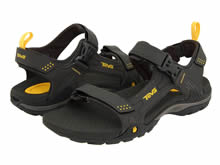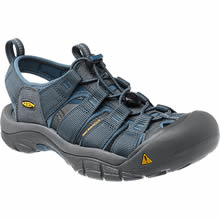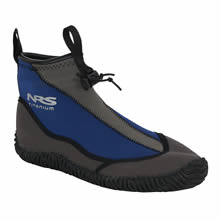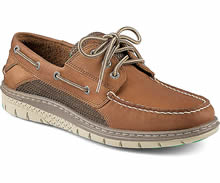Taking an unexpected dip in the cold water of Montana is truly a superb method to wake up. Being fed primarily from snowmelt, the waters run chilly even in late summer.
One reason many visitors to Montana discover the cold waters of Montana rivers first hand is due to taking unexpected falls in the water. Often, these unexpected dips in the river are caused by wearing the wrong footwear. Wearing normal beach sandals, flip flops or sneakers is an invitation to slip on a wet, slimy rock and tumble into the river or, worse, sprain or break an ankle.
So, to help prevent Montana visitors from taking an unexpected dip in a river—and perhaps an unhappy visit to a local hospital—I’ve prepared this guide about the very exotic and interesting topic of water footwear.
Contents of this article include:
What Is Water Footwear?
Water footwear, as the name suggests, are various footwear specifically designed for activities that take place in or around the water. For Montana, this basically means footwear that provides traction and safety for sports such as kayaking, river rafting, float fishing, shore fishing and tubing. In short, water footwear is for people who expect to go in and out of the water frequently and need the benefits these specialized shoes and sandals provide.
Four Types of Water Footwear
There are four basic types of water footwear that most people use. Each type has its own uses. Some are meant for yachts, some are best for river floats, others are ideal for canoeing, and yet others are meant for a mixture of activities.
Learn more about various water footwear products in the following articles.
 |
Water Sandals - A good choice for people who don't mind a bit less traction and protection of the foot in comparison to what a water shoe provides. More Info |
 |
Water Shoes - The quick dry and comfort of a water sandal with the toe protection and traction of a normal shoe. The most versatile of all water footwear. More Info |
 |
Wet Shoes - A niche shoe that works well for specific uses, but doesn't have much versatility or use out of the water. More info |
 |
Boat Shoes - Great for yachts, large boats and the shore "nightlife." Not so great for most uses in Montana. More info |
Reasons to Use Water Footwear
There are several specific reasons to use water footwear when engaging in water sports activities. While these benefits are further flushed out on other pages, a quick summary of these benefits include:
- Safety - Water footwear is designed to provide excellent traction on wet and slippery surfaces, whether it be rocks or the deck of a million dollar yacht.
- Comfort - Water footwear is much more comfortable than regular shoes once wet, since water footwear will not become soaked or waterlogged once submerged.
- Durability - Water footwear is specifically designed to be durable (i.e. - no mold problems or breaking down of leather due to constant immersion in water).
So, if you plan to engage in active water sports in Montana or elsewhere, give some strong consideration to getting a good pair of dedicated water footwear for your needs. Your feet, and ankles, will be happy that you did.
Benefits & Drawback of Each Type of Water Footwear
The pro's and con's of each type of footwear.
- Boat Shoes – Boat shoes work great if you have a yacht or a fancy fishing boat and won't be clambering on and off slippery shore rocks, etc.. However, if you plan on rafting, kayaking or fishing from shore or from a boat that requires you to enter the water, leave boat shoes in the car. Boat shoes are basically quick drying leather moccasins. Their traction is good but nothing special. And they don't offer the true quick drying that a good quality water shoe or sandal does. Additionally, they take a bit more time to drain completely. Boat shoes can get wet, but continuous submersion—such as what happens when getting in/out of a raft—isn’t a boat shoes strong suit. More information about Boat Shoes.
- Water Sandals - Quick drying and ideal for summer use. Being a sandal, water drains freely and I personally find sandals more comfortable while out on the water than water shoes. They lack foot protection on both the front and top of the sandal, however. When walking in slippery places, some care needs to be exercised to prevent nasty toe and toenail injuries. More than a few toenails have been ripped up by falls when wearing sandals. Despite the limited foot protection, water sandals are still the most popular water footwear type during the warmer months. More Information about Water Sandals.
- Water Shoes - A mixture of both the water sandal and a more normal shoe. These shoes come in manyt different styles---some more closely resemble a sandal while others look an exotic athletic shoe. Either way, water shoes provide the most foot protection. Moreover, water shoes are ideal if you plan on doing any hiking away from the water, especially in steep or rocky terrain. Due to their versatility, water shoes are especially popular among canoeists and overnight floaters. More information about Water Shoes
- Wet Shoes - A niche footwear type, a wet shoe is designed for "on the water" use. A wet shoe has fine traction while in the raft, but the lack of a thick sole makes doing any sort of walking out of the boat difficult and painful unless done on a smooth area, such as a parking lot, beach or grassy area. Sea and lake kayakers do find wet shoes useful, since they keep feet warm during colder weather. More information about Wet Shoes.
So Which Type of Water Footwear To Get?
Just a quick breakdown on who might benefit from a particular type of shoe to get.
- Boat Shoes – You have a yacht or fancy fishing boat and will seldom, if ever, submerge the shoe will wearing them. Good shoes for the nightlife, too, since they are comfortable and look nice.
- Water Sandals - My favorite for summer uses on a Montana river while doing single-day float trips. Sandal style is very comfortable, stays dry and has superb traction all while keeping the feet cool on warm, sunny days. If you can live without the foot protection of a water shoe, a sandal is a good choice. If you plan on hiking with them, however, sandals are poor choices due to their lack of foot protection and support.
- Water Shoes - The most versatile of the water footwear, the water shoe is the best footwear to use if you'll be spending lots of time in the water and doing hiking away from the water. Water shoes are popular with overnight floaters and those who plan to spend a lot of time "on-shore" hiking, especially in rocky terrain.
- Wet Shoes - Best for lake kayakers and sea kayakers who will put in/take out their boat at places that are paved or grassy smooth. Lack of a sole and poor traction out of the water makes these shoes rather dangerous to use in rocky and uneven terrain. Thus, if you plan on doing stuff "out of the water," leave these shoes at home.
